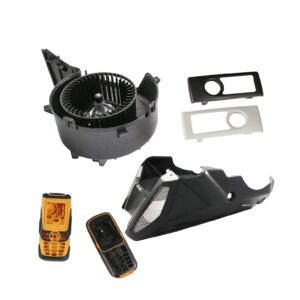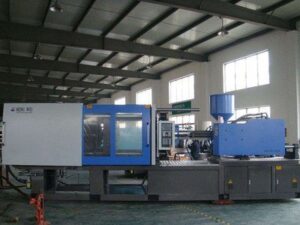Are you curious about plastic molding and how it can be used to create a variety of products? Plastic molding is a process that has been around for decades and is a great way to create a variety of items. From small and intricate items to large and complex products, plastic molding is a reliable and cost-effective manufacturing process. In this comprehensive guide to plastic molding, we’ll provide you with everything you need to know about this popular manufacturing process. We’ll share an overview of the process, the different types of molding, and the advantages of using plastic molding. We’ll also discuss some of the latest advances in plastic molding and what you should consider when selecting a process. So, if you’re interested in learning more about plastic molding, you’ve come to the right place!
Overview of Plastic Molding
Plastic molding is a manufacturing process that creates parts by injecting molten plastic into a mold. The mold is usually made of metal and can be thermoformed or machined. From there, the molten plastic is cooled and taken out of the mold, creating a part that closely resembles the mold. The process is used to create a variety of products, including medical devices, car parts, and construction materials. And, with advancements in technology, manufacturers are looking to expand the applications of plastic molding even further! Although it’s a tried-and-true process, advances in technology have lead to an increase in demand for plastic molding. And, a need for greater education on the process has also emerged. As a result, manufacturers are investing in additional research and development focused on improving the process. So, if you’re curious about plastic molding, you’ve come to the right place! In this guide, we’ll provide you with an overview of the process, the different types of molding, and the advantages of using plastic molding. We’ll also discuss some of the latest advances in plastic molding and what you should consider when selecting a process. So, if you’re interested in learning more about plastic molding, you’ve come to the right place!
Types of Plastic Molding
There are a variety of plastic molding processes that can be used to create products. In fact, there are so many different types of molding processes, it can be difficult to know what’s best for your application. In general, there are two categories of plastic molding: thermoforming and injection molding. Thermoforming involves heating a sheet of plastic and forming it into a desired shape. Injection molding involves injecting molten plastic into a mold where it cools and takes the shape of the mold. From there, the plastic is taken out of the mold and formed into a final part. Other types of plastic molding may include rotational molding or stretch blow molding. Of course, there are some variations of each process. But, they’re all designed to create similar products. There are also other types of molding that are used with plastics, such as metal molding, wood molding, or graphite molding. However, these processes are beyond the scope of this guide. Of course, there are benefits and drawbacks to each type of molding. So, it’s important to review each process to select the best type for your application.
Advantages of Plastic Molding
There are numerous advantages to using plastic molding. First, it’s a versatile process that can create a variety of products. It can be used to create small, intricate parts and large and complex products. Additionally, the process is fast and efficient. It can create products in less than 5 minutes, which is faster than other manufacturing methods. Additionally, it’s cost-effective. Plastic molding is a cost-efficient process and can be used for a variety of materials. You can use recycled materials or even formulate your own thermoplastic. In fact, it’s possible to create a custom plastic that fits your application. Another advantage of plastic molding is its design flexibility. You can create products with complex shapes and designs, which can be difficult with other manufacturing methods. And, it’s possible to create one-off or low-volume production runs.
Latest Advances in Plastic Molding
As demand for plastic molding has increased in recent years, researchers and manufacturers have invested in additional research and development. As a result, they’ve made advancements in the process to make it more efficient and effective. One of the latest advances in plastic molding is the development of machines that can be programmed for more complex products. This gives manufacturers the opportunity to create one-off or low-volume production runs with greater accuracy. Additionally, new materials have also emerged that can be used for this process. For example, graphite materials are now available for use in plastic molding. These materials are flexible, lightweight, and heat-resistant. They have many of the same properties as plastics, but they can withstand higher temperatures. This makes it possible to use these materials in a variety of industries and applications.
What You Should Consider when Selecting a Process
When selecting a process, there are many factors to consider. First, you want to determine what type of material you want to use and where it comes from. It’s important to select a material that meets your needs and is cost-effective. It’s also important to select a material that blends well with other materials. You also want to consider the design of your product. Each process has a different design process that must be followed. And, some processes may not be suitable for your application. Next, you want to determine the volume of products you plan to make. If you plan to produce a high volume, you may want to consider an automated process that can increase efficiency. You also have to consider the complexity of your product. Some processes are better suited for simple parts, while others can create the most complex designs. It’s also important to consider the environment where the process will be used. Some processes may require special conditions or machinery that is difficult to install.
Safety Considerations for Plastic Molding
There are many safety considerations to keep in mind when working with plastic molding. First, it’s important to follow proper health and safety guidelines. Selecting the correct protective gear and following proper hygiene practices can help prevent injuries. Next, you want to consider the environment where the process will be used. It’s important to select a location that is well-ventilated to remove the fumes created by the process. It’s also important to select a location that has easy access to water to clean the equipment. And, it’s important to select a location that has ample room for the equipment and materials. You also want to consider the equipment used for the process. It’s important to select equipment that can withstand the temperatures and pressures of the process. Additionally, it’s important to select equipment that can be easily cleaned and maintained to prevent contamination.
Common Plastic Molding Materials
There are many materials that can be used in plastic molding. Each material has its own set of properties, as well as advantages and disadvantages. It’s important to consider the properties of each material to select the best material for your application. You can use a variety of materials to create products with plastic molding. These include: Acrylic – Acrylic is an excellent material for forming single-color parts. It’s a durable material that can withstand high temperatures and pressures. ABS – ABS is a common thermoplastic that is commonly used for creating decorative and functional parts. ABS is a relatively easy material to work with and can create a wide variety of designs. PVC – PVC is a common material that can be used for a variety of applications, such as plumbing and vinyl for flooring and wall coverings. PVC is a versatile material that is easy to use and can create a wide variety of designs. Polycarbonate – Polycarbonate is a strong and durable material that can withstand extreme temperatures. It’s commonly used for safety goggles and safety shields.






